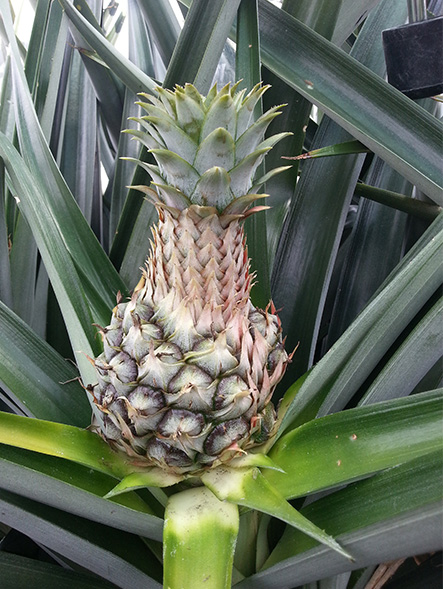“Mal de cintura” disorder characterization of pineapple MD2 in agroclimatic conditions of flat area of Valle del Cauca, Colombia

Abstract
In some localities in Colombia a physiological disorder called "Mal de cintura", is present in MD2 pineapple productive farms. It is a deformation of the fruit due to the incomplete development of contiguous flowers that produces a physical damage (external appearance); generating fruit rejection in the market. Factors that trigger this problem are unknown. This research was carried out on two farms in Valle del Cauca, Colombia, soil moisture and ambient temperature conditions were evaluated on the expression of the physiological disorder. In farm 1, vegetative and productive phases of the crop were evaluated. The results indicate that the plants were not in water deficit before, during or after flowering, ruling out this factor on the expression of the physiological disorder. During flowering, maximum temperatures reached 35°C and minimum temperatures 18°C were recorded, giving an alert on this variable due to the presence of the physiological disorder of 96% of the crop. In farm 2, a more detailed monitoring of the temperatures was carried out during the inflorescence development. In this period, maximum temperature inside crop was 58,5°C and the minimum was 15,5°C, symptoms of deformation were present in 78% of the crop. Results were inconclusive about temperature influence on fruit deformation. A chemical analysis of inflorescences tissue with and without expression of the physiological disorder was performed to validate the influence of a nutritional problem. Results indicated that damaged inflorescences had higher copper, zinc and manganese contents than healthy inflorescences.
Keywords
Ananas comosus L. Merr., Physiological disorder, Flowering, Soil moisture, Nutrition, Temperature
References
Bartholomew, D.P. and S.B. Kadzimin. 1977. pp. 113-156. Pineapple. In: Alvim, P.T. and Kozlowski, T.T. (eds.). Ecophysiology of tropical crops. Academic Press, London. Doi: https://doi.org/10.1016/B978-0-12-055650-2.50010-1
Cabal, L.M. 2014. Manual del sistema de gestión de calidad. CI Elixir SAS, Guadalajara de Buga, Colombia.
Carr, M.K. 2012. The water relations and irrigation requirements of pineapple (Ananas comosus var. comosus): A Review. Exp. Agric. 48(4), 488-501. Doi: https://doi.org/10.1017/S0014479712000385
Codex Alimentarius. 2011. Standard for pineapples CXS 182-1993. FAO; WHO, Rome.
Crane, J. 2019. Pineapple growing in the Florida Home landscape. Publ HS7 original publication 1975. In: Horticultural Sciences Department, UF/IFAS Extension, https://edis.ifas.ufl.edu; consulted: April, 2019.
Cunha, G.A.P. 2005. Applied aspects of pineapple flowering. Bragantia 64(4), 499-516. Doi: https://doi.org/10.1590/S0006-87052005000400001
Diggle, P. and C. Mulder. 2019. Diverse developmental responses to warming temperatures underlie changes in flowering phenologies. Integr. Comp. Biol. 59(3), 559-570. Doi: https://doi.org/10.1093/icb/icz076
Friend, D.J.C. and J. Lydon. 1979. Effects of daylength on flowering, growth, and CAM of pineapple (Ananas comosus [L.] Merrill). Bot. Gaz. 140(3), 280-283. https://doi.org/10.1086/337086
Hedhly, A. 2011. Sensitivity of flowering plant gametophytes to temperature fluctuations. Environ. Exp. Bot. 74, 9-16. Doi: https://doi.org/10.1016/j.envexpbot.2011.03.016
Higuchi, H., N. Utsunomiya, and T. Sakuratani. 1998. High temperature effects on cherimoya fruit set, growth and development under greenhouse conditions. Sci. Hortic. 77(1-2), 23-31. Doi: https://doi.org/10.1016/S0304-4238(98)00160-5
Kennelly, M., J. O'Mara, C. Rivard, G. Miller, and D. Smith. 2012. Introduction to abiotic disorders in plants. In: American Phytopathological Society-APS. The Plant Health Instructor. Doi: https://doi.org/10.1094/PHI-I-2012-10-29-01
Lin, J.-A., H. Susilo, J.-Y. Lei, and Y.-C.A. Chang. 2019. Effects of fertilizer nitrogen shortly before forcing through flowering on carbon-nitrogen composition and flowering of Phalaenopsis. Sci. Hortic. 252, 61-70. Doi: https://doi.org/10.1016/j.scienta.2019.02.006
Maia, V.M., R.F. Pegoraro, I. Aspiazú, F.S. Oliveira, and D.A.C. Nobre. 2020. Diagnosis and management of nutrient constraints in pineapple. pp. 739-760. In: Srivastava, A.K. and C. Hu (eds.). Fruit crops: Diagnosis and management of nutrient constraints. Elsevier, Amsterdam. pp. 739-760. Doi: https://doi.org/10.1016/B978-0-12-818732-6.00050-2
Marín, I.C., I. Loef, L. Bartetzko, I. Searle, G. Coupland, M. Stitt, and D. Osuna. 2011. Nitrate regulates floral induction in Arabidopsis, acting independently of light, gibberellin and autonomous pathways. Planta 233(3), 539-552. Doi: https://doi.org/10.1007/s00425-010-1316-5
Sukhvibul, N., A.W. Whiley, and M.K. Smith. 2005. Effect of temperature on seed and fruit development in three mango (Mangifera indica L.) cultivars. Sci. Hortic. 105(4), 467-474. https://doi.org/10.1016/j.scienta.2005.02.007
Sun, X., J. Bucher, Y. Ji, A.D. van Dijk, R.G.H. Immink, and G. Bonnema. 2018. Effect of ambient temperature fluctuation on the timing of the transition to the generative stage in cauliflower. Environ. Exp. Bot. 155, 742-750. Doi: https://doi.org/10.1016/j.envexpbot.2018.06.013
USDA, United States Department of Agriculture. 1999. Guía para la evaluación de la calidad y salud del suelo. Washington, DC.
Vásquez, H.D., R. Saavedra and S.H. Saavedra. 2012. Piña (Ananas comosus L. Merr.). pp. 776-801. In: Fischer, G. (ed.). Manual para el cultivo de frutales en el trópico. Produmedios, Bogota, Colombia.
Wang, S.S., Y.L. Li, and X.Z. Wen. 2018. Effect of increasing humidity on flowering, fruit-setting and pollen characteristics of tomato under heat stress. Acta Hortic. 1227, 305-312 Doi: https://doi.org/10.17660/ActaHortic.2018.1227.37
Ye, T., Y. Li, J. Zhang, W. Hou, W. Zhou, J. Lu, Y.Xing, and X. Li. 2019. Nitrogen, phosphorus, and potassium fertilization affects the flowering time of rice (Oryza sativa L.). Glob. Ecol. Conserv. 20, e00753. Doi: https://doi.org/10.1016/j.gecco.2019.e00753
